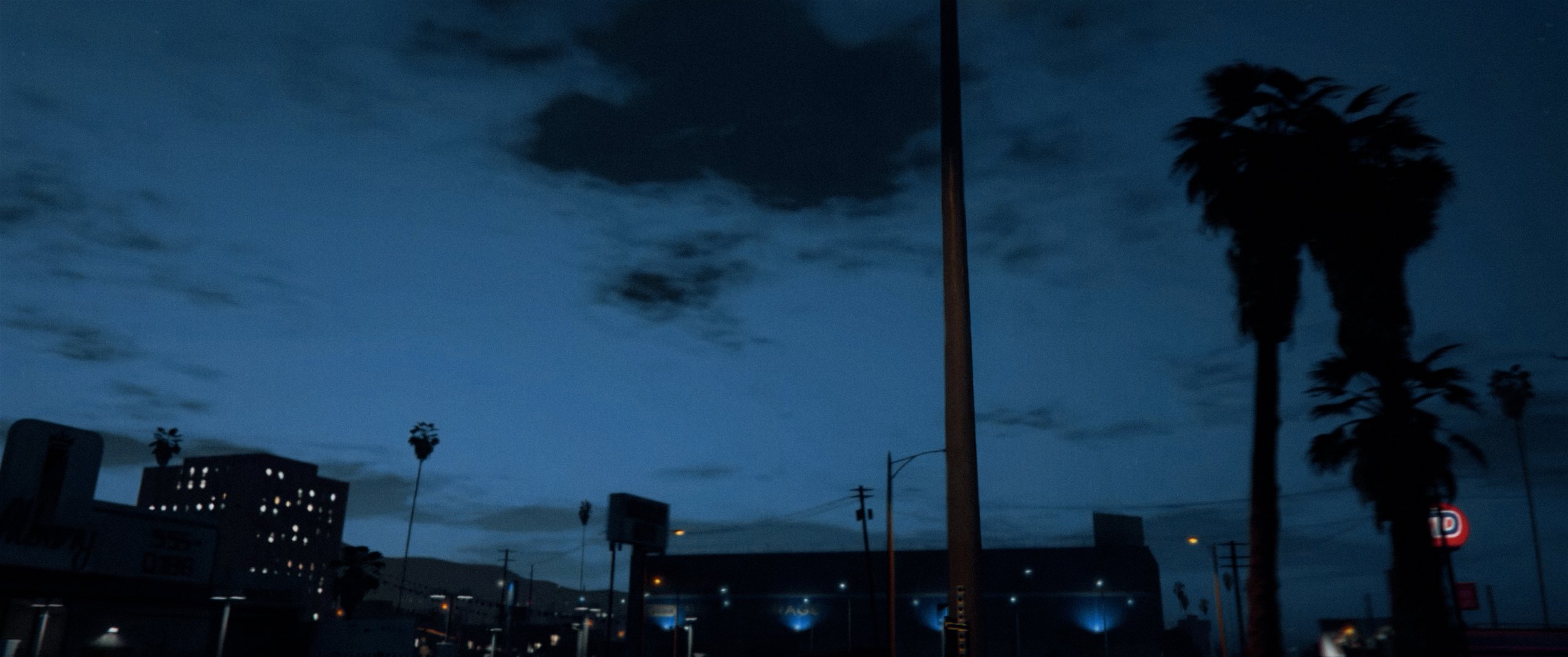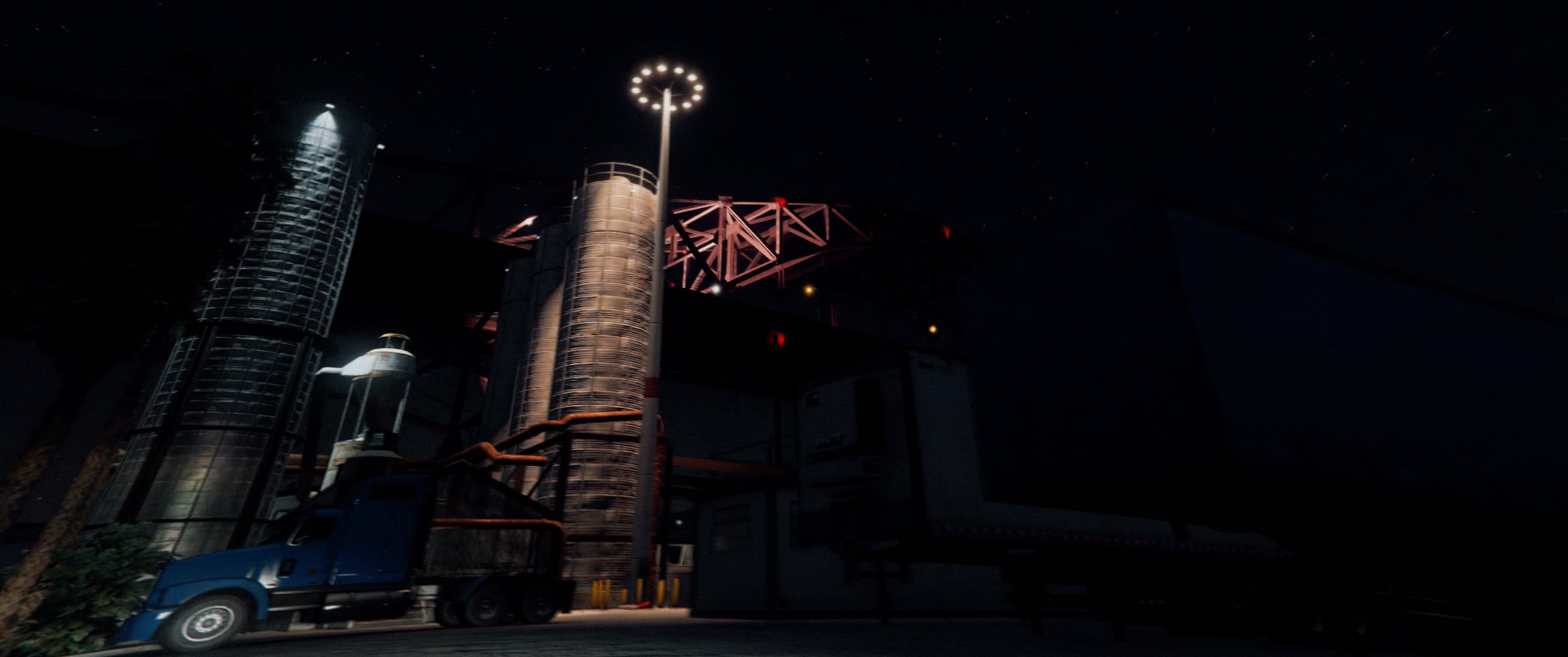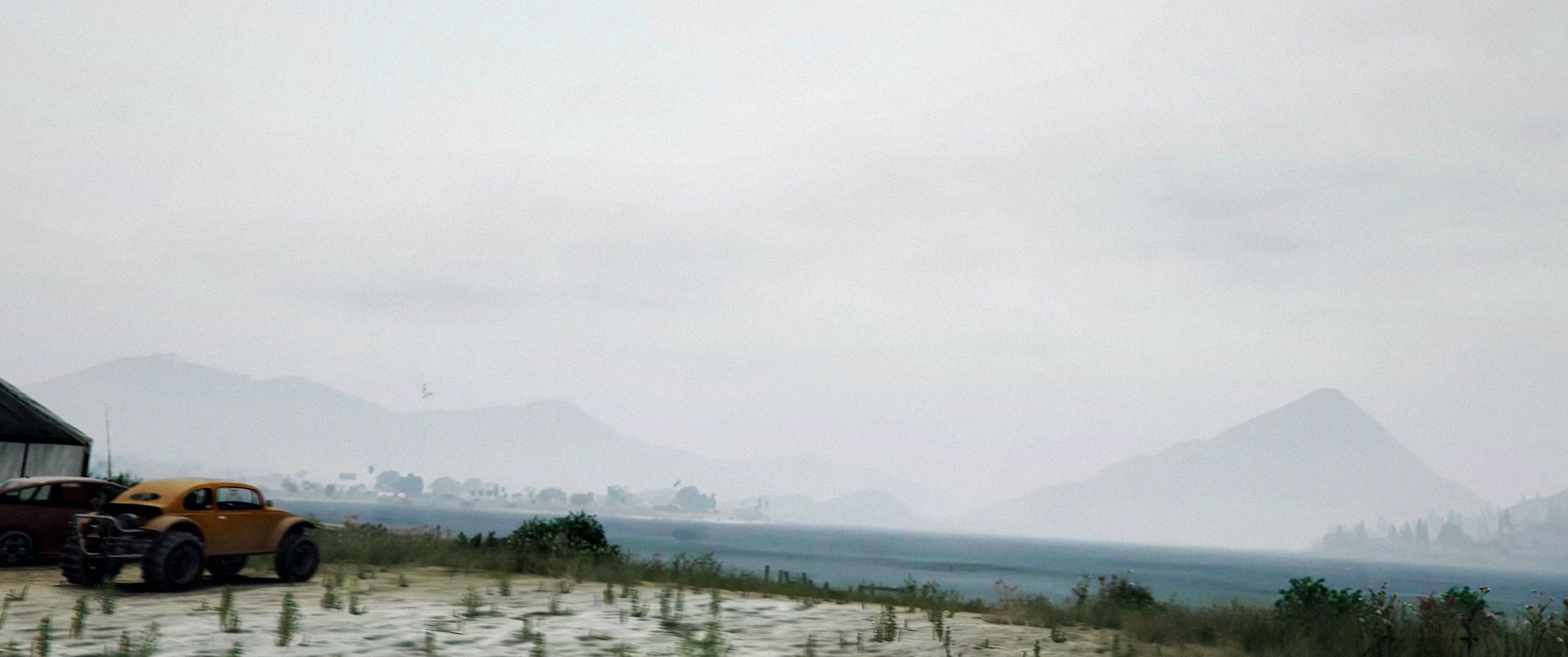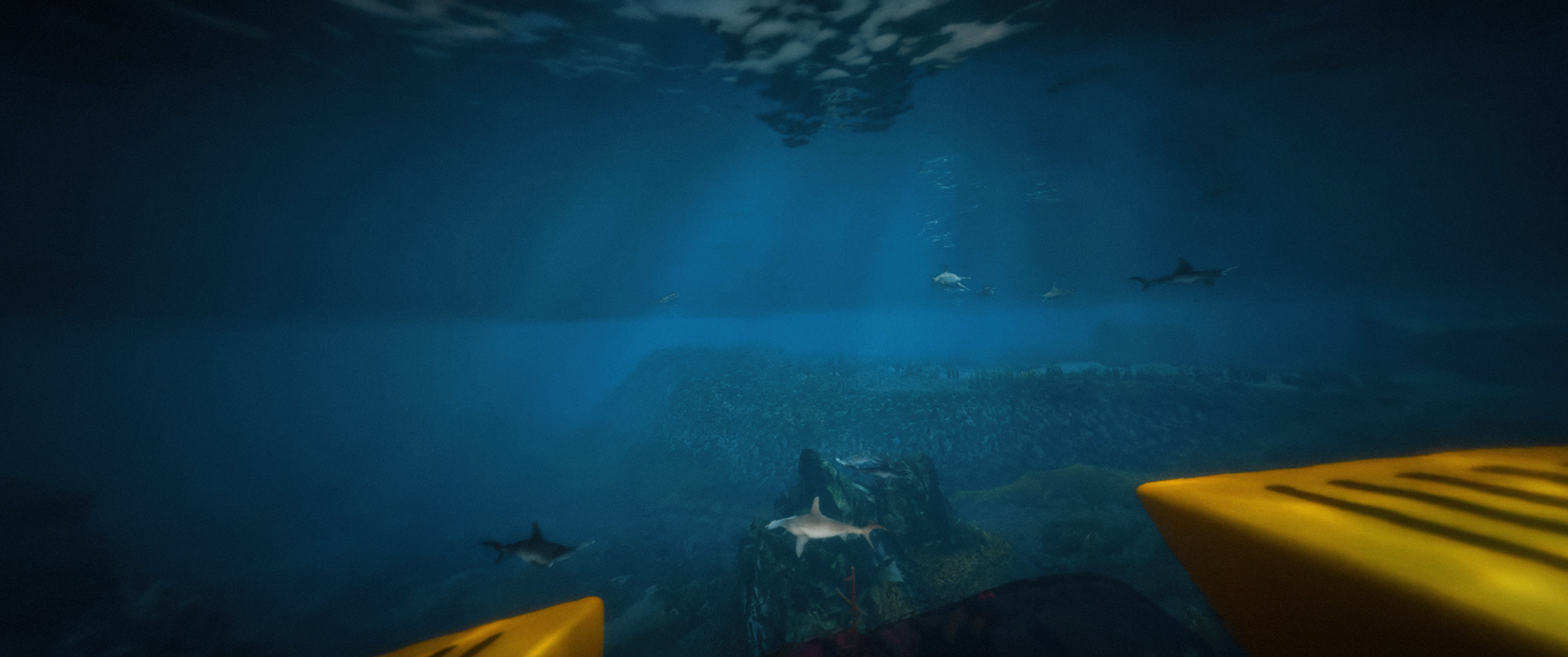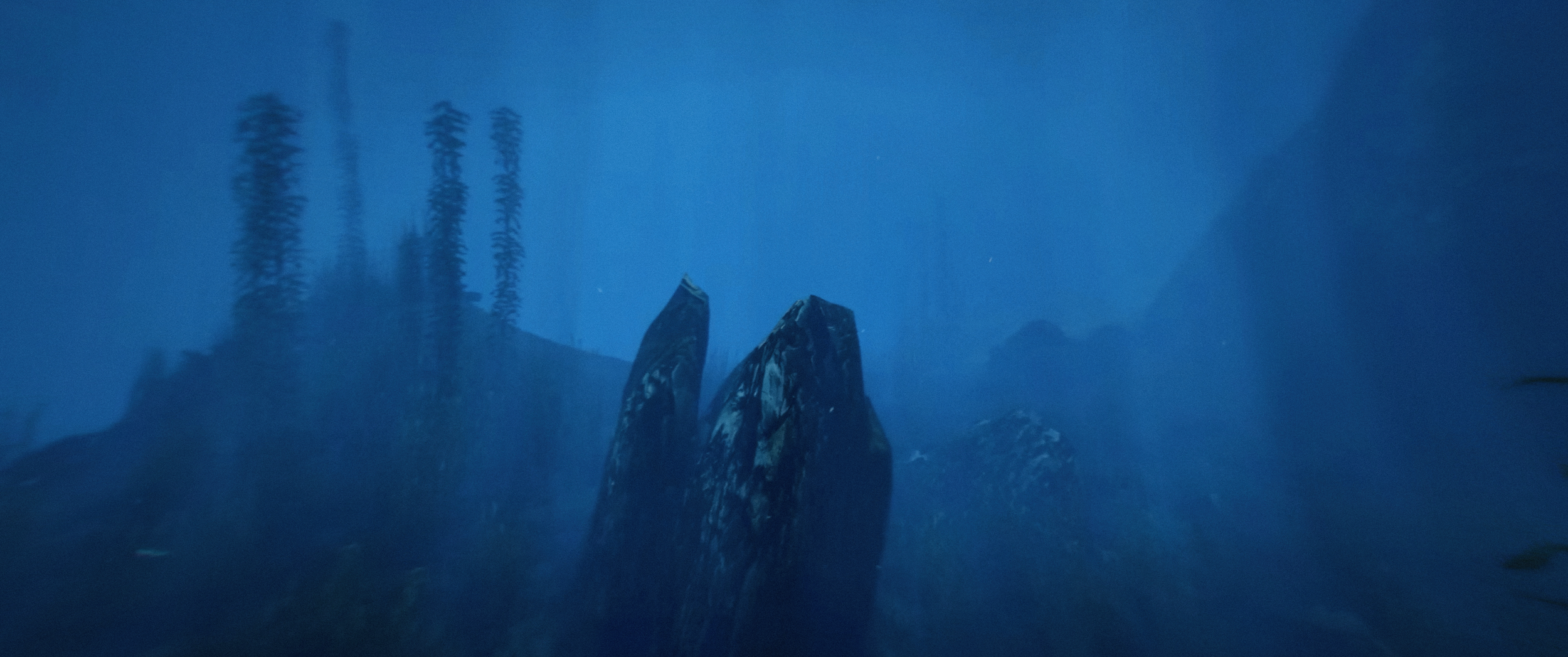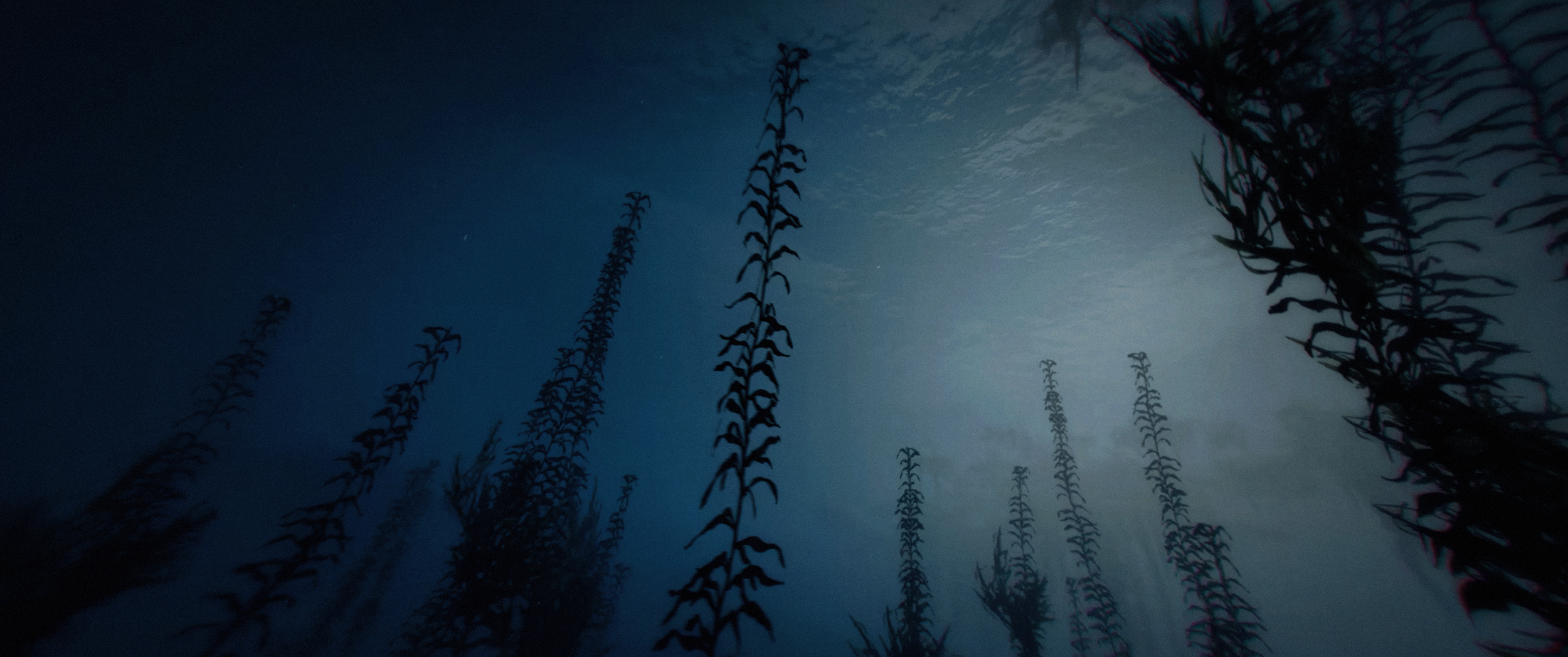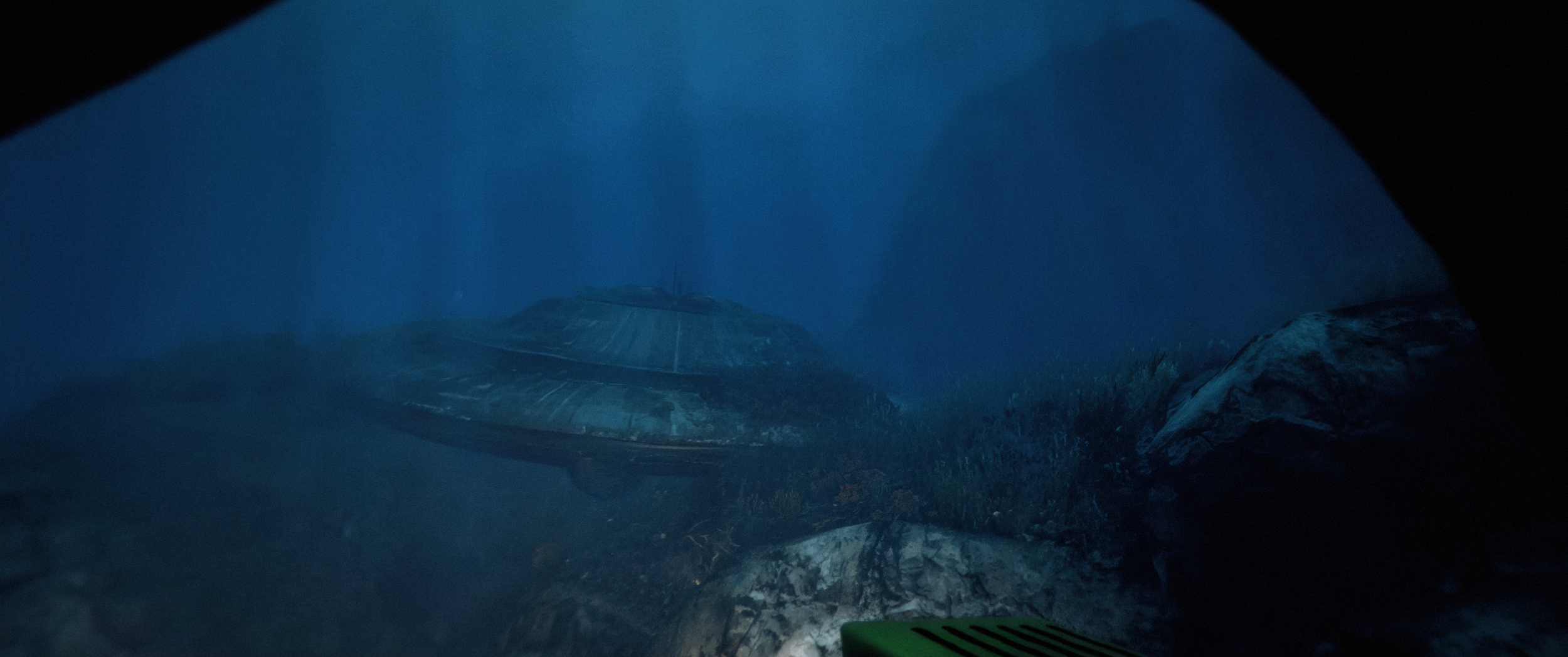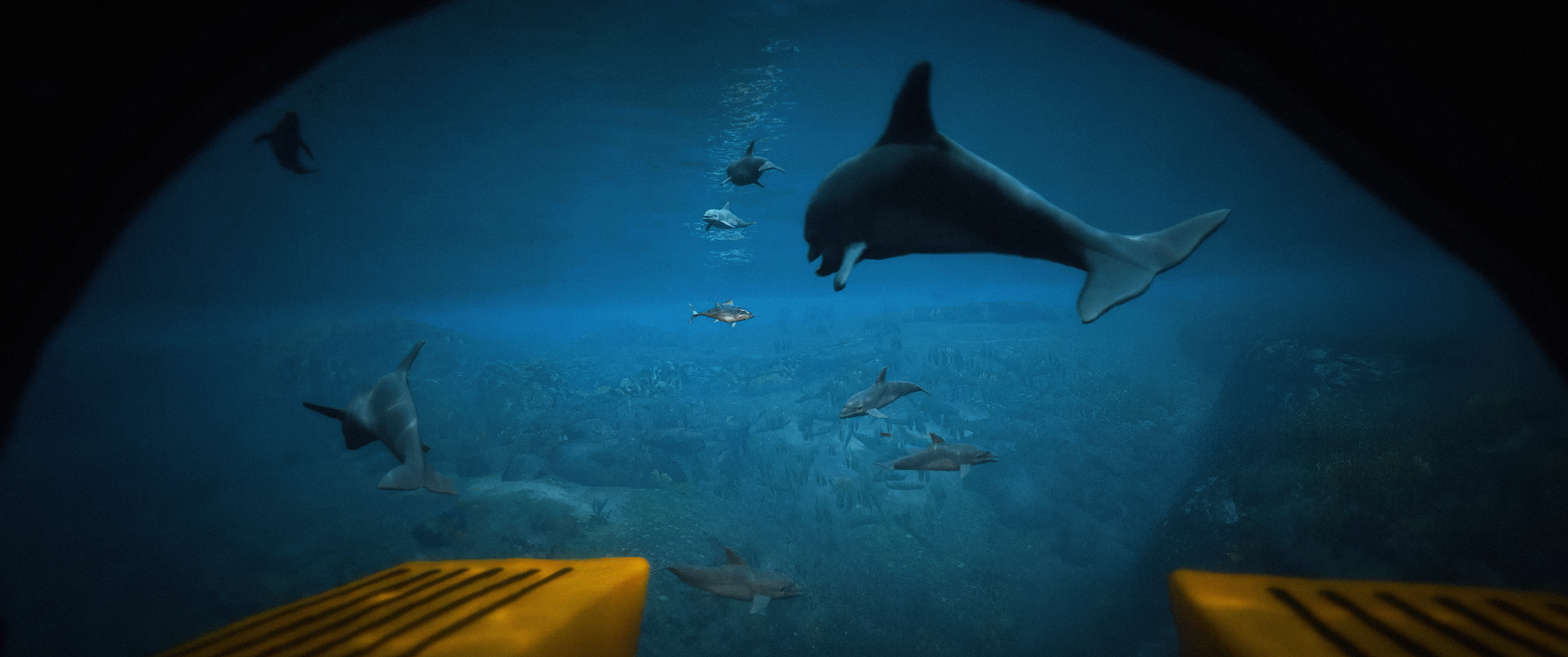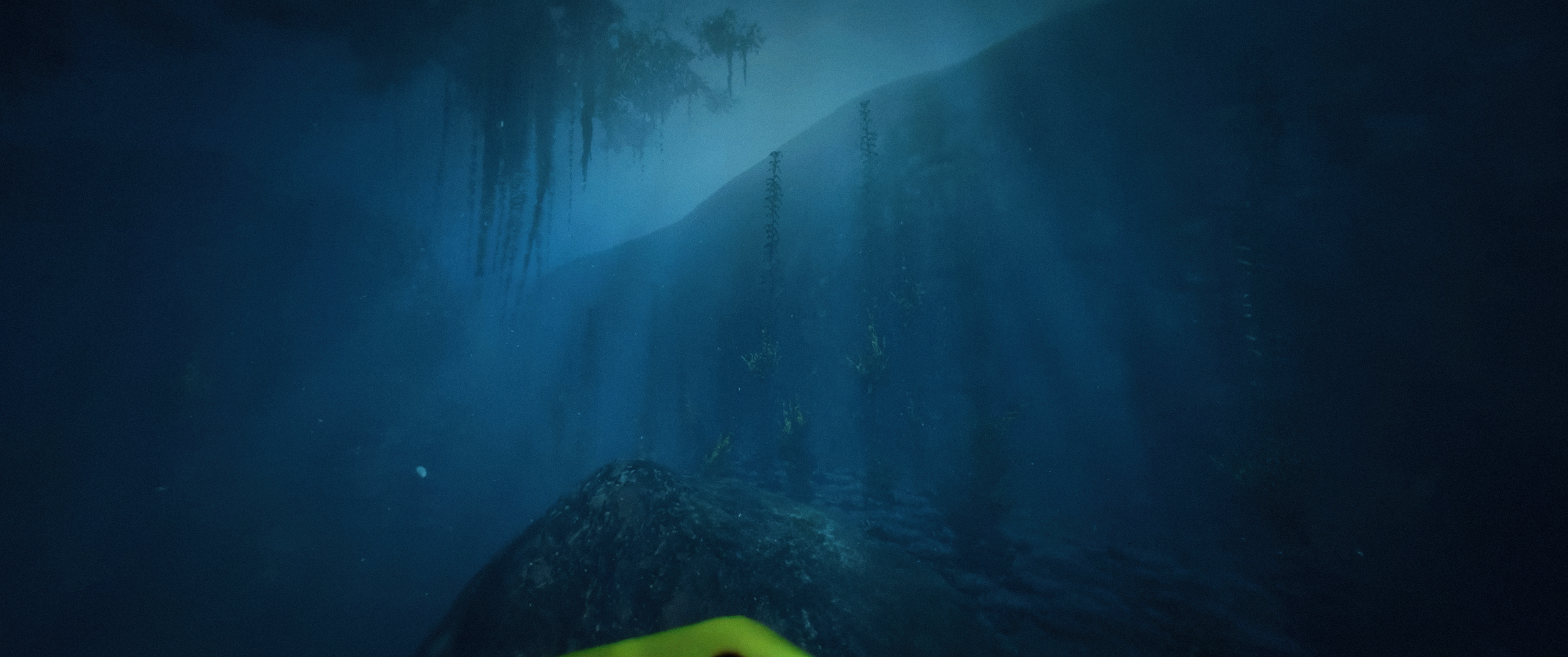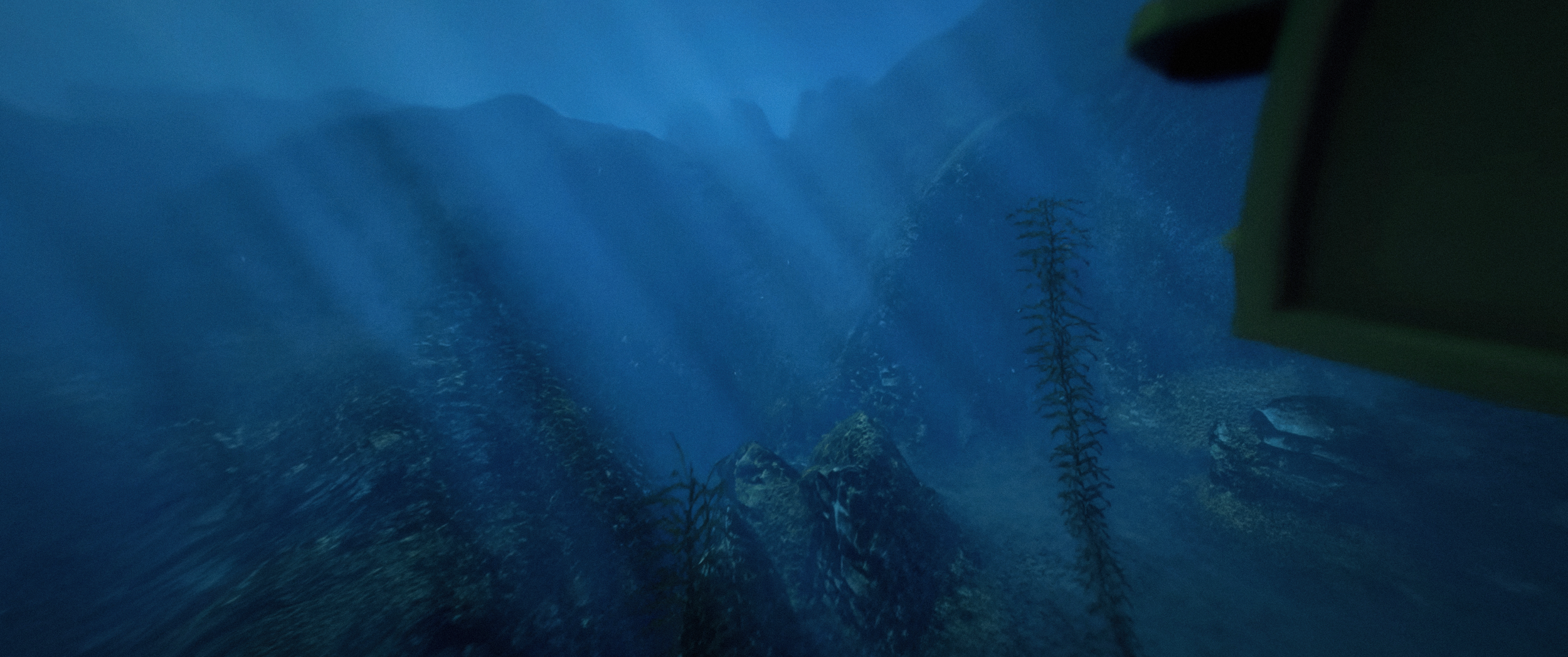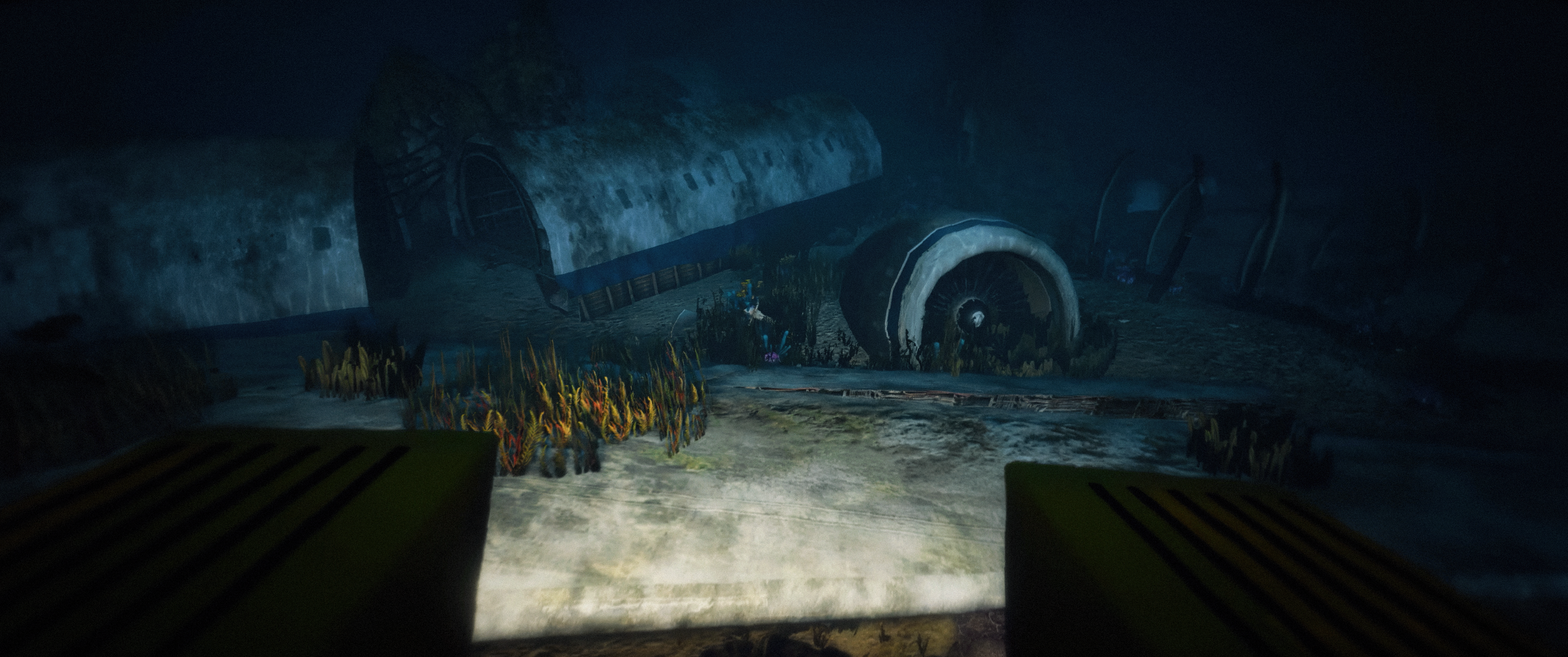Regression 4
digital video 4096 x 1716 (4k Scope), color, sound (Stereo, -14LUFS; Stereo, -23LUFS), 13’ 51” (original), 2023, The Netherlands
Created by Jordy Veenstra
Three years have passed since the unveiling of Veenstra’s Regression 3, a machinima that explored the aerial expanses of Grand Theft Auto V’s vast territory. Today, we stand at a significant juncture as Regression 4 further solidifies the significance of the series. This installment takes audiences on a highly experimental cinematic journey, focusing on the underwater realms of Los Santos and Blaine County and some of the many secrets found within.
Jordy Veenstra is a video editor, experimental filmmaker, machinima artist, and front end developer based in Amsterdam, the Netherlands. In his practice, Veenstra connects videogames, experimental narratives and technology through the medium of machinima and his “practice of distortion” framework, consisting of rules and values that revolve around the “distortion” of otherwise clear video-game generated images and audio, with the intent of moving away from perceiving the film as a “product from a videogame” and more as a “product of cinema” by using various values found in traditional cinema such as cinematic resolutions and aspect ratios, 24 frames per second, color grading, motion blur and grain. Veenstra’s work has been exhibited internationally, including at the 2020 and 2022 editions of the Milan Machinima Festival, while Regression Trilogy has been featured on VRAL in 2020.
Matteo Bittanti: Overall, Regression shows a creative and technical progression – no pun intended –, with each film exploring a unique aspect of Grand Theft Auto’s – be it modes of transportation, aerial perspectives, urban environments or, in this case, aquatic environments. Your filmmaking strategies also seem to fluctuate considerably, ranging from structured scripting to more spontaneous methods. Specifically, in Regression 4, you mentioned that the selection of shots was guided by “feeling and interpretation.” Could you elaborate on how this intuitive approach either converges with or departs from conventional cinematic editing practices, as well as how it compares to your methods in earlier installments?
Jordy Veenstra: What all Regression films have in common is that they move away from conventional cinematic editing practices. The first two films primarily focused on experimental rhythmic editing; a form of editing where the visuals were on par timing-wise with the music to a certain extent. This way, both the video and the audio expanded upon each other and complemented each other. The video and audio were also edited simultaneously. In this regard, Regression 3 and 4 stepped away from that technique and used something that I refer to as “F&I”, that is, Feeling and Interpretation. In this case, the video and audio are separated during post production and edited separately based on feeling and current interpretation of the film, resulting in a higher experimental-laden result.
I am merely guided by the footage that is in my dailies bin; the emotions that are evoked inside of me while listening to an audio track during a music search. My timeline is a tabula rasa. Besides a few initial creative sparks, I lack clear direction regarding the eventual appearance of the film. I am guided by the visual contents of the shot; I let my emotion and feelings guide me to decide on what to do next. When I rewatch the film and come across a piece of footage where the feeling simply isn’t right, I place it somewhere else, adjust it (regrade it in later stages of post-production), or simply delete it. In flat terms, I am sometimes literally throwing stuff at the wall to see what sticks and what falls flat. It is not until the film finally conveys the emotion that I felt, the ideas I have in mind, the brainwaves I wanted to implement, the atmosphere I tried to visualize that I will finally conduct a second viewing a few days later. Once satisfied at that point in time, it is then that the edit is locked, the audio mix conceived, and the process starts over again until the film is completed.
Interestingly, the F&I technique I am using is not new. Experimental editing or avant-garde editing has been around in films ever since the inception of experimental films over one hundred years ago. Non-linear narratives, visual experimentation, poetry, innovation, and different camera techniques were at the forefront of this captivating film genre. It has been present in numerous films across many experimental genres, such as Joris Ivens’s Rain (1928) a short film of the city symphony genre, shot in an experimental manner yet edited based around a specific narrative: raining in Amsterdam, Hans Richters’s Vormittagsspuk (1928), an experimental dada-inspired experimental short which utilizes stop-motion and live action effects and Hollis Frampton’s Ordinary Matter (1972, an experimental and explorational journey through various places in the United Kingdom and the United States, which seems it has been edited with a like-wise approach. A last example of an experimental narrative, but not so based on F&I since there is little to no editing, is Hollis Frampton’s Lemon (1967, a one-shot, silent, and unedited film primarily focused on the use of material, object, mass and light as it highlights the appearance of a lemon into tungsten light and its later disappearance into the darkness.
There are endless things that set conventional and experimental cinema apart. Think about the amount of participation required by the viewer, the level of passivity or activity required when the film is “consumed”, the narrative structure, the messages that are “encoded” into these films, the narratives that were utilized, the filmmaking techniques used, the visibility and actual usage of the narrative, the “decoding” strategies used by viewers, the way how viewers are steered into choosing the decoding strategies they ended up using, the general execution of production and post-production, the contents of the frame, and so forth. Of course, there are a number of similarities between conventional and experimental cinema. Both like to be inventive, for example. Think about the follow-shots in Stanley Kubrick’s The Shining (1980) and Gus van Sant’s Elephant (2003) and the fast-cutting/flash-cutting techniques utilized in the Saw (2004-ongoing) series. In addition, both conventional cinema and experimental cinema like to push the boundaries of storytelling. Think of how the Saw franchise spreads such an extensive narrative over a large number of movies, easily moving back and forth between events/moments in time over the course of multiple films. This results in a mind-blowing amount of “persons-of-interest”, main characters and side characters, that all have their own traits, actions and stories. You could easily fill an address book (or rolodex, if that is your thing) with these events and characters. The main narrative is of utmost importance in this series as it serves for the justification of the tests and games set up by the protagonist John Kramer and the people that are forced to participate in them. Literally almost every single event that takes place in the films expands upon, partially explains or changes the story.
I’d like to re-mention Bert Haanstra’s Zoo (1961) as an experimental example. The idea of narrative is present to a lesser extent, but still yet pushed into new, inventive, and experimental territory as it forces the viewer to choose an interpretation of the narrative: does man watch animal, or is man being watched by animal? Viewers must make their decision based on the images alone.
What all experimental examples mentioned above have in common is their way of utilizing invention, cinematography, narrativity and experimentation. This is what differs these films, and Regression 4, from conventional cinema approaches. Of course, conventional cinema may be experimental at times, but most of the time these still contain a larger narrative of some kind that the film tries to pinpoint over the course of its runtime. The editing is used to establish the narrative or message that needs to be encoded for the audience.
In experimental cinema, this convention is “distorted” and broken, rather leaving the narrative to interpretation and thus more cryptic. It is much looser and freeform, so to speak. It forces higher levels of participation and decoding from the viewers side in order to understand the images that have been presented on screen, to decode these and label them with meaning. Here, I’m referring to Stuart Hall’s model of encoding/decoding (1973, 1980).
Matteo Bittanti: What I find truly intriguing about your creative process is the remarkable fusion of your extensive knowledge of experimental cinema and your fluency in the languages of both traditional filmmaking and video games. This synthesis is a rarity in the world of machinima, where a prevailing tendency toward a more mainstream, vernacular approach often prevails. Additionally, your astute observations on the Saw series reveal a deep familiarity with Hollywood productions. Yet, in spite of this, you steadfastly pursue a path characterized by distinctly experimental and avant-garde aesthetics. In this regard, can you elaborate on the “practice of distortion” framework that you often utilize in your work? How does it help in transforming video game generated images into a “product of cinema”? Does that imply that cinema is the benchmark to which machinima should aspire, and therefore the best way to watch machinima is projected onto a screen, rather than on a monitor? Is machinima a quintessentially example of post-cinema, then?
Jordy Veenstra: For me, the “Practice of Distortion” framework is not so much a benchmark to which machinima should aspire. Each machinima artist has their own benchmark, rules, and practices, which is what makes machinima an ever expanding, innovative and exploratory medium. I am not trying to change that in any way. I am merely trying to expand upon a plethora of possible production processes found in machinima; by presenting a different perspective in the form of distorting otherwise extremely clear video-game generated images (and audio) with the primary intent on moving away from perceiving the film as a “product from a videogame” and more as a “product of cinema” by using various values found in traditional cinema such as cinematic resolutions, 24 frames per second, color grading and numerous visual effects such as vignettes, motion blur and grain. I have created the “Practice of Distortion” framework to show the cinematic potential of what machinima could be; to demonstrate that the “power of the silver screen” can also be yielded in machine and game-based cinema.
Machinima, just like cinema, can be viewed on any device. Throughout the “jungle of screens” that we find ourselves in on a daily basis in modern day society, the choices and places to watch films and content are practically endless. It depends what device you use as to how effective certain elements of the practice of distortion framework will be. You won’t see much of a difference between 1080P HD and 4K Ultra HD on most phone or tablet screens, for example. The viewing methods are huge factors in depending how effective the framework really is. The practice of distortion framework is best experienced on middle to larger devices such as TV’s, monitors, and screens since various elements from the Practice of Distortion framework will have a better effect, such as the grain, framerate, and color grading. This is also due to the larger possibility of positive immersion, engagement, and perception of cinematic elements. Of course, I make my work with all screens in mind.
Machinima represents far more than a mere byproduct of video games; it stands as an established genre that has matured gracefully over the years. Gradually, it has been garnering increased recognition from the public and even occasionally securing a place in mainstream media. Yet, it’s clear that machinima holds untapped potential that is waiting to be harnessed.
In my view, machinima possesses the same capacity to captivate audiences on the silver screen as traditional cinema does. However, this potential has yet to fully materialize in the majority of machinima productions I encounter, leaving me with a sense of unfulfilled opportunity. What I aim to convey is that there exists a reservoir of potential for cinematic phenomena to be seamlessly integrated into the realm of machinima, a potential that remains largely untapped in the current landscape. In essence, I believe there is ample room to push the boundaries of machinima beyond its present scope, unlocking new realms of artistic expression and storytelling within this dynamic medium.
For starters, in most cases, videogame worlds can be recognized by their colors and “hue”. In Grand Theft Auto V, for example, there is a yellowish hue hanging over the map. Within seconds, most viewers familiar with the game would make the instant connection with the game by merely seeing that yellowish color, leaving out further engagement and perception. By shifting the hues and implementing further color grading while in post, it forces more participation from the viewer to comprehend and understand where they are currently at. It also may unconsciously surpass some of the expectations a viewer might have before starting the film as viewers will always have some expectations of your work, be it conscious or unconscious, no matter how much they know about your film.
As a second example, I would like to highlight the use of 60 frames per second in most machinima. There is a lot of machinima that benefits from this framerate and where it serves a dedicated purpose. However, when I see 60 frames per second in machinima, I instantly make the connection towards videogames, and the “the higher the frame rate, the better” mindset during gameplay that is so omnipresent in the gaming community. This way, it does now allow me to break with the convention that I am watching a “game”. I cannot easily create the link between the game and cinema this way.
This is why I love using the traditional 24 frames per second. It instantly and unconsciously creates the connection with cinema for the viewer and makes it easier to steer the viewer in the direction I want him to go to; having his focus on “cinema”, not on “the game” and seeing the film that way: as a product of cinema and not a product of the game.
Machinima is post-cinema. It is a special, unconventional, digital, accessible, contemporary, and participatory way of filmmaking that shifts the way of how we interact with film, co-creation and meaning making and presents us with practically endless possibilities. The contemporary cinematic landscape is always shifting. Cinema has undergone a transformative shift, becoming increasingly accessible and flexible in both consumption and creation. The spectrum of how cinema can be perceived and interpreted has expanded to encompass limitless genres and possibilities. Today, there are more avenues than ever for crafting cinematic experiences, and, naturally, an abundance of ways to engage with cinema beyond the confines of traditional theaters. This evolution parallels the dynamic nature of machinima.
Matteo Bittanti: You’ve brought up some crucial insights. Your observation regarding the “framerate mindset” within the gaming community is quite perceptive and brings to mind an installation by Filip Kostic titled Running at Frame Rate (2020). This artwork effectively comments on the marginal utility of advocating for ever-increasing rates of refresh. At the same time, your familiarity with both cinema and gaming allows you to experiment with the genres and the conventions of both media. Specifically, the Regression series appears to be a crystallization of your wider artistic ambitions and your experimental methodology in filmmaking. It notably and overtly aims to dissolve the demarcation lines between video games and cinema. Given your multifaceted background in various media, technology, and academic disciplines, could you elaborate on how these diverse influences converge in your work to probe both social and artistic themes via machinima? To distill it further: What, in your view, is the essence of machinima that sets it apart from both video games and traditional cinema? I realize I’ve posed variations of this question in our past interactions – often in the same conversation – so forgive the recurring theme.
Jordy Veenstra: Cinema is intertwined with machinima, and machinima, in turn, is intricately linked to cinema. Consider machinima as the vital third pillar, akin to a missing link in the triangular relationship between video games and cinema. It acts as a bridge that connects these realms. It is, from a productional perspective, practically limitless in opportunities, highly participatory yet extremely rewarding. If there is a game or an engine with extensive documentation, there is some kind of way. The fluidity, speed and ease with which machinima can be created compared to cinema, yet able to yield likewise results is absolutely mind-blowing. Machinima fixes the slow, extensive pre-production timeframe and budget-related issues that plagues traditional cinema, yet lets you break free from the narrative that the game tries to convey. It lets you build upon the existing narrative that is found in the game and recreate your own. Machinima allows you into uncharted territory by using mods and console commands, doing what was impossible at first with simple ease.
As I once said before, and I still stand by it: Machinima has no limit, and so has your imagination.
Matteo Bittanti: If I may synthesize your approach, for you machinima is cinematic or post-cinematic. Lev Manovich would likely approve your take. It is clear that your main references come from filmmaking. In our previous conversation, three years ago, you cited a range of cinematic influences for the original Regression series, including Bert Haanstra’s Zoo (1961) and Glas (1958), Joris Ivens’s The Bridge (1928), and Vittorio de Sica’s Ladri di Biciclette (Bicycle Thieves, 1948). As the series has evolved, can you shed light on the primary cinematic inspirations that shaped the creative vision for Regression 4, if any? You partially answered this question already, but I would love it if you could expand your cinematic horizon.
Jordy Veenstra: The four films mentioned above serve as the main skeleton and backbone for Regression as a whole in terms of inspiration. I still watch these films every now and then to gain additional insights and inspiration. All of these films document the daily routines of several characters from different perspectives, similar to what is done in Regression: the documentation of “place” from different perspectives. Regression 4 (and the upcoming Regression 5) mainly used these films as a form of inspiration for the production process. During the post-production process for Regression 4, I gained some additional inspiration for the color grading out of the Saw franchise as it often utilizes green/yellowish, grungy colors. Additional inspiration for the color grading was found in some of my favorite films containing very contrast- and color-rich grades such as No Country For Old Men (2007).
All the shots in Regression 4 contain a dark green overlay to emphasize both the grittiness of the world we are currently in, together with the true meaning of Regression: the representation of a perfect and sophisticated, contemporary America with massive underlying issues and societal cracks. I have also experimented with color contrasts, such as with the yellow color of the submarine alongside the teal water of the ocean. During one shot, we see several wrecks laying on the ocean floor, while during the next we are literally “swimming with dolphins” under the Los Santos sun. I found this idea of conflict and contrast very suiting compared to the meaning behind Regression. The greenish overlay was the finishing touch in this case.
Matteo Bittanti: Given the unfortunate reality of dolphins facing mass mortality due to rising ocean temperatures in the real world, it’s quite likely that Grand Theft Auto V will become one of the few accessible virtual environments where one can still interact with (the simulacra of) these remarkable marine creatures. You describe Regression 4 as a “highly experimental visual study,” uniquely framed from the perspective of a submarine journey. Could you elaborate on the artistic considerations that influenced the choice of this underwater vessel as your narrative device? Could you share the inspiration behind selecting water as the primary perspective for this installment, after the air element of the prior episode? What specific visual or thematic elements were you able to capture through this submarine lens that might have been inaccessible from other vantage points? Additionally, was your decision to use a submersible as the focal point influenced in any way by recent real-world events, such as the tragic incident that resulted in the loss of an entire crew en route to the Titanic wreckage?
Jordy Veenstra: The idea to choose water for the fourth film was the most logical continuation of the series for me after having had three films based on ground and air (with various small nods to water). Furthermore, water makes up a significant part of the Grand Theft Auto V map, yet it remains highly underexposed and underexplored. I really wanted to give the numerous bodies of water in San Andreas the attention it deserved. Interestingly, it features a lot of marine life, things to see and secrets to uncover. I initially wanted to make the film from a complete GoPro perspective; placing the camera on the character’s head while diving. I conducted a few tests with this idea in-game while doing various activities: walking, driving in cars, motorcycles, running, flying in airplanes, in combat with people, etc. Unfortunately, I was unable to get the result I wanted as arms and legs would often clip into the view. Sometimes the camera would clip out of the direct scope of the vehicle or character as well, rendering the shots useless.
This is why I decided to go the submarine route. It contained a very large window in the front of the machine, allowing for beautiful wide-angle representations of the San Andreas seafloor and its inhabitants, while at the same time including a bit of the machinery and interior found inside of the submarine in some of the shots. In style with Regression 2 and 3, it gave me the freedom to primarily focus on the submarine and to create experimental representations of the ocean taken from within, around- or on the submarine. I believe that Regression 4 would have been a lot more redundant in terms of shots and perspectives if I had continued to use the Head Go-Pro perspective, since it forced me to use a single camera perspective over the course of the entire film. The idea was not completely wasted, though, as I used a Fish-Eye Go-Pro perspective for some shots in the film during post-production later on.
A great recurring visual theme in the film, which I would be unable to find anywhere else in the game, is the beautiful volumetric yet highly mysterious atmosphere and lighting once you dive a bit deeper into the ocean. Of course, the lighting in general in Grand Theft Auto V is stunning as always, but sometimes during certain moments while being underwater it is really in a league of its own.
Let me conclude by briefly discussing the scope of influence of Regression 4. The film was not influenced by the tragic events that occurred while en-route to the Titanic wreckage in any way, but, of course, I understand why the question is asked as the film was released within three months after the dreadful events took place. The definitive idea for the film was conceived last year and the film was produced over the course of two weeks in May, while the accident had not taken place yet (it happened a month later). I am aware of the timing and some of the similarities, but it really is a highly unfortunate coincidence.
Matteo Bittanti: Regression 4 marks a significant milestone in your series, being the first installment to boast a 4K Scope resolution. Could you delve into the implications of this technical advancement? How do you anticipate this visual upgrade will impact audience engagement and perception, particularly when the film is showcased in various settings such as film festivals, museums, and art galleries?
Jordy Veenstra: Every single detail, no matter big or small, contributes and changes the overall perception, engagement, and interpretation of a film. This could be an object strategically placed in the background, a sequence of shots, or more technical aspects such as framerates, resolutions, and aspect ratios. I do not foresee an active increase in engagement on YouTube as the film is, even on 4K resolution, heavily compressed. YouTube content is often watched on smaller devices such as smartphones, computer screens and tablets. While YouTube content can be mirrored and watched on televisions, I believe the compression would eventually kill the immersion the technical advancement of a 4K Scope resolution would bring. The color grading would look different on a lot of different devices. Computer screens use sRGB, TV’s use REC709/REC2100, Apple screens have their own color settings as well. The increase in engagement should be much more visible inside of a physical and higher controlled setting, such as a screening in a cinema or viewing on a dedicated streaming platform. The image quality, aspect ratio and framerate are more on-par and controllable with what the viewer is (unconsciously) grown accustomed to during earlier cinematic experiences and the film is actively presented the way as how it was intended to be, without having to worry about differences in color grading and audio- or video compression.
I am actively considering making a 5.1 surround mix for Regression 4 for these cinematic purposes as well. Not only does it allow me to get one step closer towards the completion of the practice of distortion framework, but it also offers another chance for potential engagement increase if the film is screened within this arena. Even if the changes in audio from Stereo to Surround are subtle in terms of Regression 4, as it primarily contains an SFX, noise and music track, I am highly convinced that the strategic placement of the mix across the 5 speakers will help with engagement and perception levels tremendously.
Matteo Bittanti: The medium is the message, indeed. When I think about people watching your machinima on a smartphone, I am instantly reminded of David Lynch’s priceless rant. Regression 4 stands out for its notably condensed production timeline, having been completed in just two weeks during May, captured entirely on a Cloud Gaming PC and involved minimal mods, emphasizing an exploratory, improvisational approach. Could you elaborate on the unique challenges and benefits that arose from this accelerated schedule? How did this intensive timeframe influence both the creative and technical aspects of your machinima? Additionally, could you contrast this experience with the production processes of your earlier installments in the series? Were there specific lessons learned from preceding iterations that informed your approach to managing such a tight timeline?
Jordy Veenstra: Every single project has its opportunities, benefits, and challenges to overcome. Having learnt from experience with many of my previous films, I try not to think anymore ‘if’ these will occur, but simply ‘when’ these will occur, in ‘what’ form or shape and if there is any way I can premeditate a fix or workaround for these. Of course, being the first Regression installment released on a 4K resolution, I had to anticipate longer rendering and mastering times. That did not turn out to be much of an issue as I prepared for this beforehand by simply allowing more time for post-production.
In our last conversation, I stated I wanted to let go of the “predetermined scripting” that was present in the first three films. Especially in the beginning it pointed out to be both a blessing and a serious challenge. The idea was to spawn into a submarine, go underwater, explore, capture, and take it from there. While it gave me a lot more creative freedom in terms of footage capturing (I didn’t have to follow a script so if it didn’t work, I could just delete it and move on), the questions that logically arose following up on that larger amount of freedom were a bit daunting as I kept asking myself the question: “When will the amount of footage be enough?” “Will I eventually be ending up capturing the same footage all over again?” “Is the perspective from the submarine good enough, as in, will it provide enough perspectives to get my point across and will it be interesting and fun to watch?”.
I did not use the first-person perspective and never booted up the Rockstar Editor to check while in production, so I honestly did not even have a clue as to what cinematic potential could be found in these demo clips. Shortly before starting production on Regression 4, I had to cancel another potential Grand Theft Auto V short as the footage turned out to be unusable after trying to manipulate the files in the Rockstar Editor. It was, however, a gamble I was willing to take as I was highly certain that, to some extent, some cinematic and machinima-based potential was to be found within these clips. Furthermore, leaving the rendering and manipulation of the clips up until after capturing had concluded forced me to refamiliarize myself with all of the footage, which in turn was believed to help me to shed new ideas and perspectives on the captured gameplay clips. This approach was more in line with the experimental approach I had aimed to use for Regression 4.
During production, I kept going; exploring the various water bodies, recording numerous areas on the ocean floor, near the surface, the inhabitants found inside of the ocean, some of the hidden secrets, the many beautiful cliffs, corals, and everything in between. The first few days I captured almost everything I saw. I utilized this approach at least for the first three days. Once I started to familiarize myself with the many water bodies found in San Andreas, I noticed a shift. There were a couple of days where I was circulating around in the map for at least an hour before I started to capture footage, allowing me to fully immerse myself within my new surroundings. I kept a brief and generic overview of what I had captured imprinted in my mind so that I had something to go on during production and prevented me from capturing the same footage all the time. This approach was a first for the series and turned out to be a very enlightening experience. It’s perhaps of interest for further films that work well with this approach, but it worked particularly well with this film as at times it simply felt that it was only me, the submarine, and the endless amount of water surrounding me. It was a very soothing and calming experience at times, helping immensely with the creative process.
Matteo Bittanti: You’ve indicated that the fifth installation of Regression is currently in post-production, while Regression 6 is already halfway through its production cycle. Without revealing too much, could you offer a glimpse into what audiences can anticipate from these forthcoming installments? Additionally, do episodes 4 through 6 constitute a second trilogy that complements the initial set, or should the entire series be viewed as a continuously evolving post-cinematic entity?
Jordy Veenstra: Of course! I’d be happy to share a few insights about both films. The fifth installment in the Regression-series is currently two-thirds in its post-production cycle. The edit has been locked and I am working on the color grading and audio mix for the film. At this point in time, I am unable to be very concise in terms of pinpointing an exact release date for Regression 5. I am still clinging onto a release somewhere during the remainder of this year, with a run out to early 2024.
The fifth film will contain the same level of technological advancement that Regression 4 had and in terms of color grading, at least in my opinion, enjoys one of the nicest-looking cinematic experiences I have been able to create thus far. Its runtime will be longer than Regression 4. Just like Regression 2, 3 and 4 did before, the fifth film will focus on the idea of an experimental visual study during various acts of “movement”
The idea of letting go of a predetermined script as a red thread for the film, if you will, was getting more and more omnipresent as the series progressed over the years. In that regard, Regression 6 is a completely different story. The sixth film will contain much more notions of a dedicated script and follows an experimental, time-based narrative. It will be similar to Regression 1 in terms of style and, for the first time in the series, stay as true as possible to the classic City Symphony genre films from the 1920s and 1930s and its many characteristics. Regression 6 aims to be a true representation of the classic city symphony (as where the previous installments have always used a more modernized approach) and is supposed to be an experimental, and highly cinematic representation of a virtual New York City.
Regression 6 is currently in production and is just over the halfway mark in terms of production, as you correctly stated. I have managed to capture over 1000 different gameplay demoes, scattered throughout the entire map and during different times of day. There are still several additional clips to be captured. Once that has been concluded, the extensive task of creating shots can finally commence. Lately I am putting a lot of inspiration out of Manhatta – a 1921 city symphony of the city of New York, created by Paul Strand and Charles Sheeler – which should help me tremendously in terms of inspiration over the course of the production period. It will be one of many movies that will serve as inspiration for me during the remainder of the (shot)production process for Regression 6. Considering that each demo should (at least) yield two usable shots, the runtime of Regression 6 will be more in line with that of a full feature film, which makes everything slowly come full circle. Three years ago, during our initial interview, I stated I would love to present a Regression film of an hour or longer. That time has finally come upon us: 2024 or 2025 to be more exact as the remaining (post)production process will take a tremendous amount of time to complete.
In the beginning I referred to the Regression series as a trilogy, unknowing whether and when I would be able to present new installments after the first three films had been released. From the beginning I have always envisioned Regression as a series, or a saga. This was due to the endless possibilities of portraying the various maps in Grand Theft Auto games. Now that production is in full swing for two upcoming films that are arguably less related to one another than the first three films, I am letting loose of the idea of a “second trilogy” and mainly refer to Regression being a series or saga.
The Regression series is constantly evolving. I am always busy with writing up and experimenting with new ideas and points of views within the Grand Theft Auto universe. Every few weeks I am changing, testing, adding, and deleting new ideas. It is, in fact, as you described extremely well, an on-going, ever-evolving experimental and post-cinematic entity.
Regression 4
digital video 4096 x 1716 (4k Scope), color, sound (Stereo, -14LUFS; Stereo, -23LUFS), 13’ 51” (original), 2023, The Netherlands
Created by Jordy Veenstra, 2023
Courtesy of Jordy Veenstra, 2023
Made with/in Grand Theft Auto V (Rockstar Games, 2013)
Mods:
ScriptHook V by Alexander Blade
MENYOO by Mafins
Mods were obtained from gta5-mods.com
Music:
Depths
Composed by SuperMash
Obtained from FreeMusicArchive.org
CC-BY 4.0 License
Dark Wind
Composed by SuperMash
Obtained from FreeMusicArchive.org
CC-BY 4.0 License
Somnolence
Composed by Kai Engel
Obtained from FreeMusicArchive.org
CC-BY 4.0 License
Salue
Composed by Kai Engel
Obtained from FreeMusicArchive.org
CC-BY 4.0 License
Counting Lights
Composed by Kai Engel
Obtained from FreeMusicArchive.org
CC-BY-NC 4.0 License
Paranoia
Composed by Kai Engel
Obtained from FreeMusicArchive.org
CC-BY-NC 4.0 License
Low Rumble Ambience
Composed by SuperMash
Obtained from FreeMusicArchive.org
CC-BY 4.0 License
Oneiri
Composed by Kai Engel
Obtained from FreeMusicArchive.org
CC-BY 4.0 License
Soli
Composed by Kai Engel
Obtained from FreeMusicArchive.org
CC-BY-NC 4.0 License


